Chaotic Analysis and Wave Photon Dynamics of Fractional Whitham–Broer–Kaup Model with β Derivative
Abstract
:1. Introduction
2. -Conformable Derivative
- ;
- ;
- ;
- ;
- ;
- is differentiable
3. Overview of Enhanced Modified Sardar Sub-Equation Approach
- Set-1: When and we acquired the solutions in the rational form:
- Set-2: When and we acquired the solutions in the exponential form:
- Set-3: When and we acquired the solutions in the hyperbolic form:when and we acquired the solutions in the hyperbolic form:
- Set-4: When and we acquired the solutions in the trigonometric form:when and we acquired the solutions in the hyperbolic form:
4. Application of Approach to Model
5. Dynamical System
5.1. Dynamical System
5.2. Bifurcation Analysis
- When , then behaves as a cuspidal point;
- When , then behaves as a center point;
- When , then behaves as a saddle point;
- When , then behaves as cuspidal and center points.
5.3. Chaotic Analysis
6. Simulations and Discussions
7. Conclusions
Author Contributions
Funding
Data Availability Statement
Conflicts of Interest
References
- Arafat, S.M.Y.; Asif, M.; Rahman, M.M. Nonlinear dynamic wave properties of travelling wave solutions in in (3+ 1)-dimensional mKdV-ZK model. PLoS ONE 2025, 20, E0306734. [Google Scholar] [CrossRef] [PubMed]
- Afridi, M.I.; Islam, T.; Akbar, M.A.; Osman, M.S. The investigation of nonlinear time-fractional models in optical fibers and the impact analysis of fractional-order derivatives on solitary waves. Fractal Fract. 2024, 8, 627. [Google Scholar] [CrossRef]
- ur Rehman, S.; Ahmad, J. Modulation instability analysis and optical solitons in birefringent fibers to RKL equation without four wave mixing. Alex. Eng. J. 2021, 60, 1339–1354. [Google Scholar] [CrossRef]
- Javeed, S.; Imran, T.; Ahmad, H.; Tchier, F.; Zhao, Y.H. New soliton solutions of modified (3 + 1)-D Wazwaz–Benjamin–Bona–Mahony and (2 + 1)-D cubic Klein–Gordon equations using first integral method. Open Phys. 2023, 21, 20220229. [Google Scholar] [CrossRef]
- Malik, S.; Hashemi, M.S.; Kumar, S.; Rezazadeh, H.; Mahmoud, W.; Osman, M.S. Application of new Kudryashov method to various nonlinear partial differential equations. Opt. Quantum Electron. 2023, 55, 8. [Google Scholar] [CrossRef]
- Veeresha, P.; Prakasha, D.G.; Baskonus, H.M.; Yel, G. An efficient analytical approach for fractional Lakshmanan-Porsezian-Daniel model. Math. Methods Appl. Sci. 2020, 43, 4136–4155. [Google Scholar] [CrossRef]
- Afridi, M.I.; Murad, M.A.S.; Faridi, W.A.; Iqbal, M.; Tawfiq, F.; Arnous, A.H. The fractional solitary wave profiles and dynamical insights with chaos analysis and sensitivity demonstration. Results Phys. 2024, 65, 107971. [Google Scholar] [CrossRef]
- Jia, H.; Nie, Y.; Zhao, Y. General Conformable Fractional Double Laplace-Sumudu Transform and its Application. J. Appl. Anal. Comput. 2025, 15, 9–20. [Google Scholar]
- Huang, X.; Li, D.; Lin, X.; Sun, H.W. A Fast Iterative Solver for Multidimensional Spatial Fractional Cahn-Hilliard Equations. J. Sci. Comput. 2025, 102, 58. [Google Scholar] [CrossRef]
- Al-Maskari, M.; Karaa, S. Strong approximation of the time-fractional Cahn–Hilliard equation driven by a fractionally integrated additive noise. Comput. Math. Appl. 2025, 180, 28–45. [Google Scholar] [CrossRef]
- Zhao, X.; Hu, B.; Sun, H. Energy Dissipation Law of the Temporal Variable-Step Fractional BDF2 Scheme for Space–Time-Fractional Cahn–Hilliard Equation. Fractal Fract. 2024, 8, 740. [Google Scholar] [CrossRef]
- Xue, Z.; Zhai, S.; Zhao, X. Energy dissipation and evolutions of the nonlocal Cahn-Hilliard model and space fractional variants using efficient variable-step BDF2 method. J. Comput. Phys. 2024, 510, 113071. [Google Scholar] [CrossRef]
- Ali, A.; Ahmad, J.; Javed, S. Exploring the dynamic nature of soliton solutions to the fractional coupled nonlinear Schrödinger model with their sensitivity analysis. Opt. Quantum Electron. 2023, 55, 810. [Google Scholar] [CrossRef]
- Chahlaoui, Y.; Ali, A.; Javed, S. Study the behavior of soliton solution, modulation instability and sensitive analysis to fractional nonlinear Schrödinger model with Kerr Law nonlinearity. Ain Shams Eng. J. 2024, 15, 102567. [Google Scholar] [CrossRef]
- Chahlaoui, Y.; Ali, A.; Ahmad, J.; Hussain, R.; Javed, S. Dynamical behavior of optical soliton solutions, time series and sensitivity analysis to the Schrödinger model with B eta fractional derivative. Opt. Quantum Electron. 2024, 56, 704. [Google Scholar] [CrossRef]
- Rehman, H.U.; Akber, R.; Wazwaz, A.M.; Alshehri, H.M.; Osman, M.S. Analysis of Brownian motion in stochastic Schrödinger wave equation using Sardar sub-equation method. Optik 2023, 289, 171305. [Google Scholar] [CrossRef]
- Wazwaz, A.-M. A reliable modification of Adomian decomposition method. Appl. Math. Comput. 1999, 102, 77–86. [Google Scholar] [CrossRef]
- El-Tawil, M.A.; Huseen, S.N. The q-homotopy analysis method (q-HAM). Int. J. Appl. Math. Mech. 2012, 8, 51–75. [Google Scholar]
- Tianle, Y.; Xing, Z.; Pang, J. Modified Hirota bilinear method to (3+1)-D variable coefficients generalized shallow water wave equation. Nonlinear Dyn. 2023, 111, 9741–9752. [Google Scholar]
- Muslum, O.; Secer, A.; Bayram, M. On solitary wave solutions for the extended nonlinear Schrödinger equation via the modified F-expansion method. Opt. Quantum Electron. 2023, 55, 215. [Google Scholar]
- Akbulut, A.R.Z.U.; Mirzazadeh, M.; Hashemi, M.S.; Hosseini, K.; Salahshour, S.; Park, C. Triki–Biswas model: Its symmetry reduction, Nucci’s reduction and conservation laws. Int. J. Mod. Phys. B 2023, 37, 2350063. [Google Scholar] [CrossRef]
- Badshah, F.; Abbas, M.; Zhou, Y.; Huang, H. Coherent control of Surface Plasmon Polaritons Excitation via tunneling-induced transparency in quantum dots. Opt. Laser Technol. 2025, 182, 112078. [Google Scholar] [CrossRef]
- Shabir, A.; Saifullah, S. Analysis of the seventh-order Caputo fractional KdV equation: Applications to the Sawada–Kotera–Ito and Lax equations. Commun. Theor. Phys. 2023, 75, 085002. [Google Scholar]
- Zhou, Y.; Wang, J.W.; Cao, L.Z.; Wang, G.H.; Shi, Z.Y.; Lü, D.Y.; Huang, H.B.; Hu, C.S. Realization of chiral two-mode Lipkin–Meshkov–Glick models via acoustics. Rep. Prog. Phys. 2024, 87, 100502. [Google Scholar] [CrossRef]
- Khan, A.; Saifullah, S.; Ahmad, S.; Khan, M.A.; Rahman, M.U. Dynamical properties and new optical soliton solutions of a generalized nonlinear Schrödinger equation. Eur. Phys. J. Plus 2023, 138, 1059. [Google Scholar] [CrossRef]
- Khan, S.; Ullah, A.; Saifullah, S.; Akgül, A. Fractional generalized perturbed KdV equation with a power law kernel: A computational study. Results Control Optim. 2023, 12, 100298. [Google Scholar]
- Saifullah, S.; Ahmad, S.; Khan, M.A.; ur Rahman, M. Multiple solitons with fission and multi waves interaction solutions of a (3+1)-dimensional combined pKP-BKP integrable equation. Phys. Scr. 2024, 99, 065242. [Google Scholar] [CrossRef]
- Gissy, H.; Ahmadini, A.A.H.; Hakami, A.H. The travelling wave phenomena of the space-time fractional Whitham-Broer-Kaup equation. AIMS Math. 2025, 10, 2492–2508. [Google Scholar] [CrossRef]
- Xu, H.; Cheng, W.; Cui, J. Multiple-soliton and periodic solutions to space-time fractional Whitham–Broer–Kaup equations. Eur. Phys. J. Spec. Top. 2022, 231, 2353–2357. [Google Scholar] [CrossRef]
- Khan, A.; Fahad Aldosary, S.; Ali Khan, M.; Ur Rahman, M.; Ahmad, S. Modulation instability analysis and optical solitary waves solutions of high-order dispersive parabolic Schrödinger–Hirota equation. Mod. Phys. Lett. B 2025, 39, 2450414. [Google Scholar] [CrossRef]
- Asghar, A.; Javed, S.; Hussain, R.; Muhammad, T. Secure information transmission using the fractional coupled Schrödinger model: A dynamical perspective. Opt. Quantum Electron. 2023, 55, 1267. [Google Scholar]
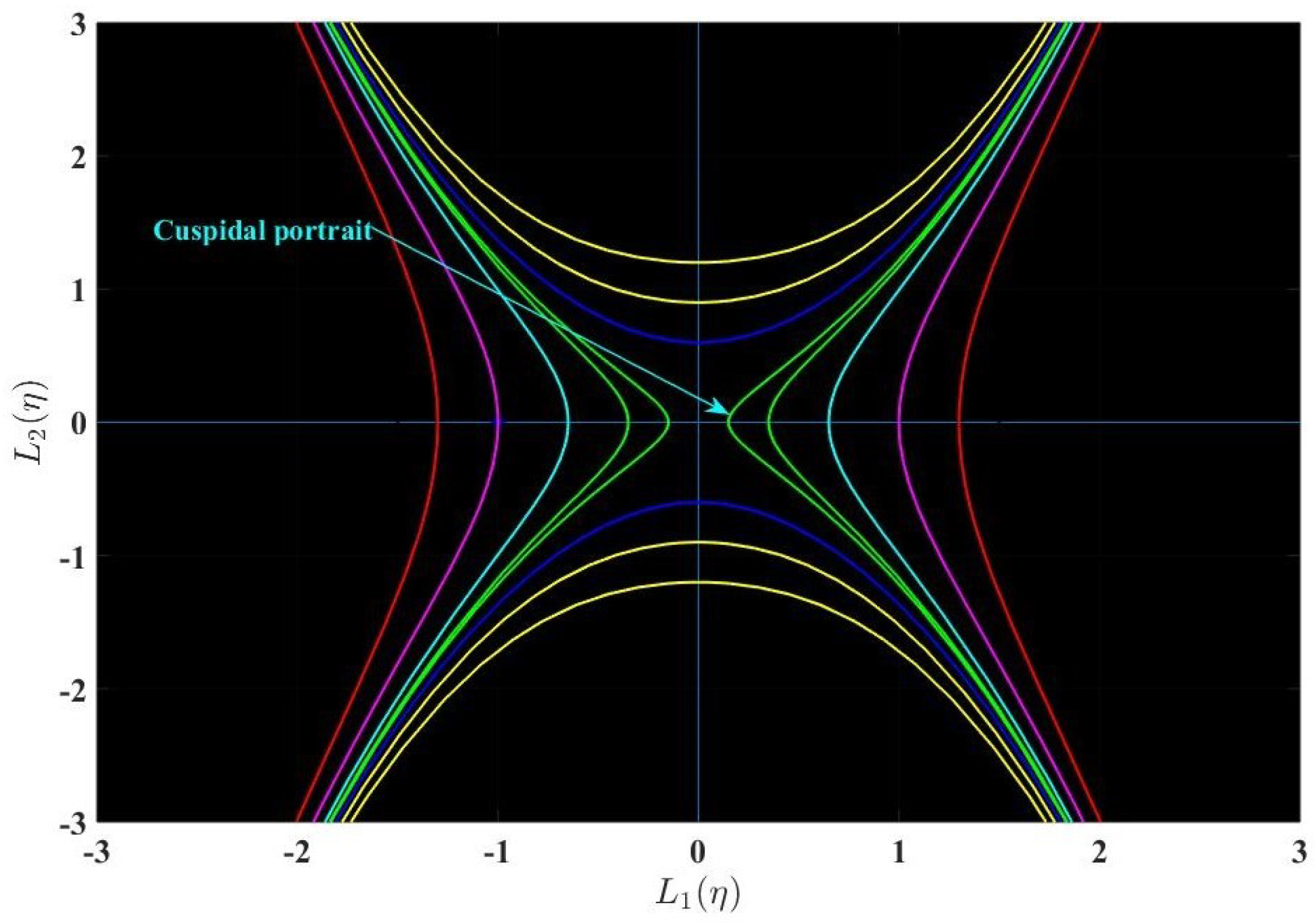
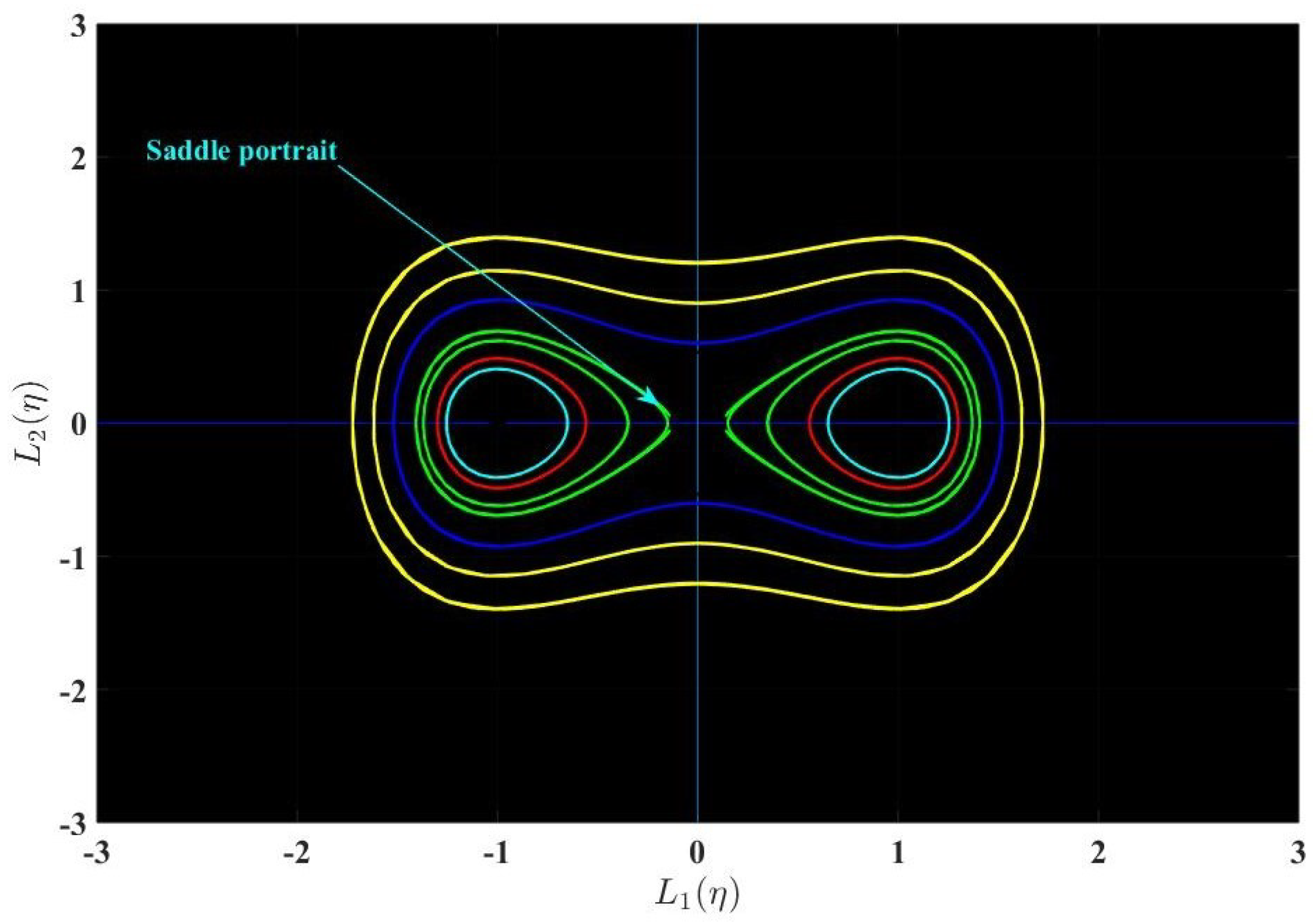
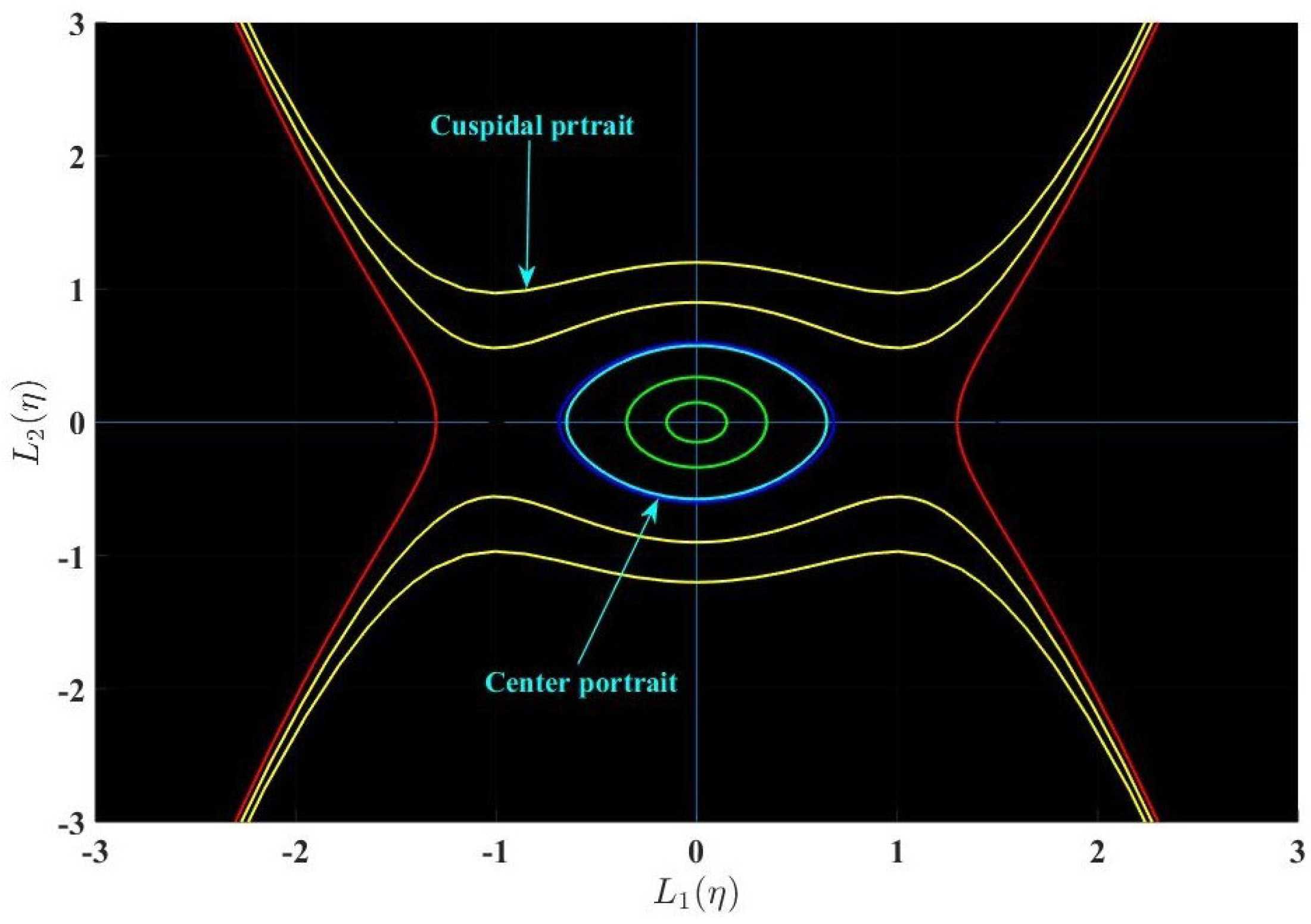
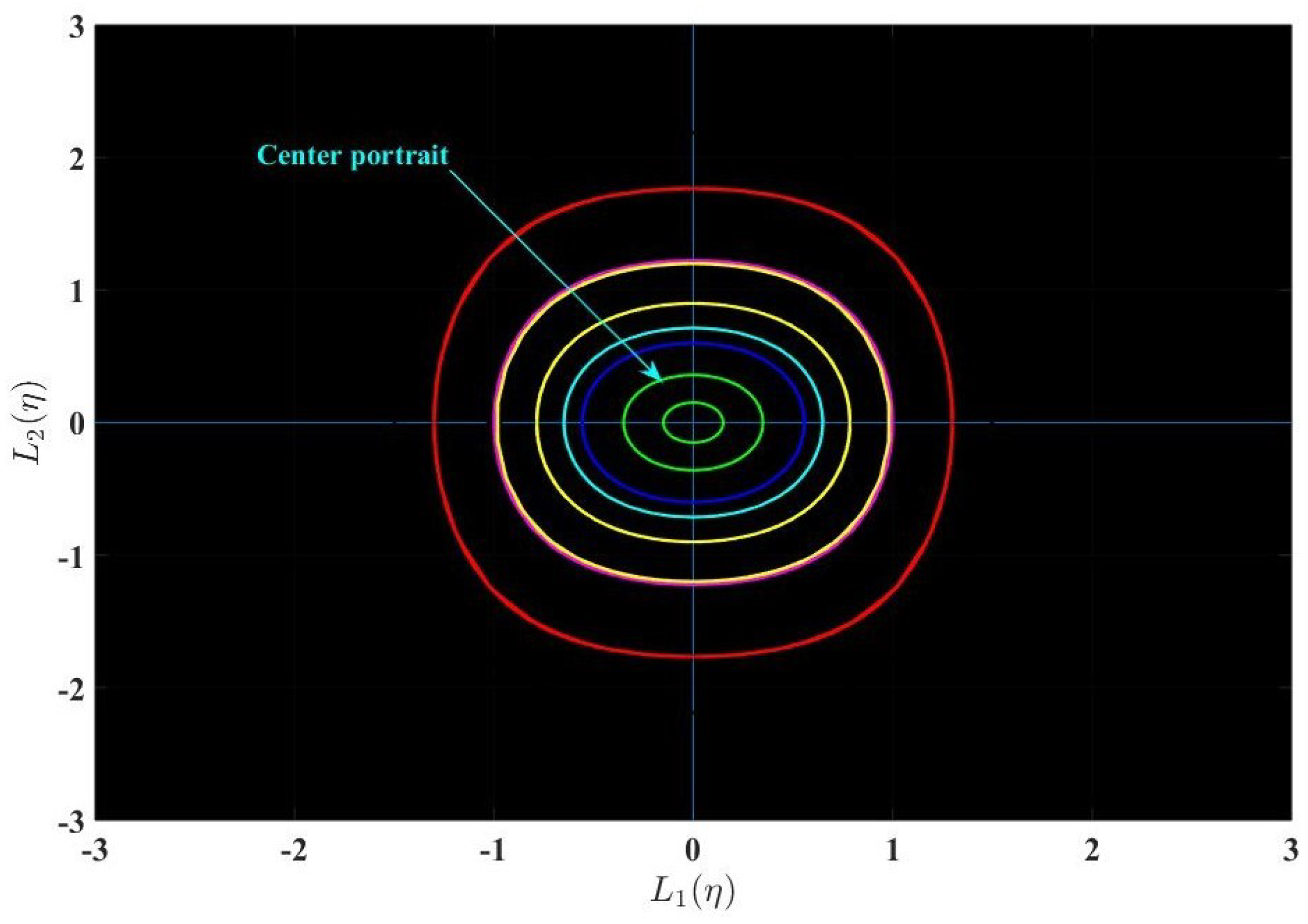
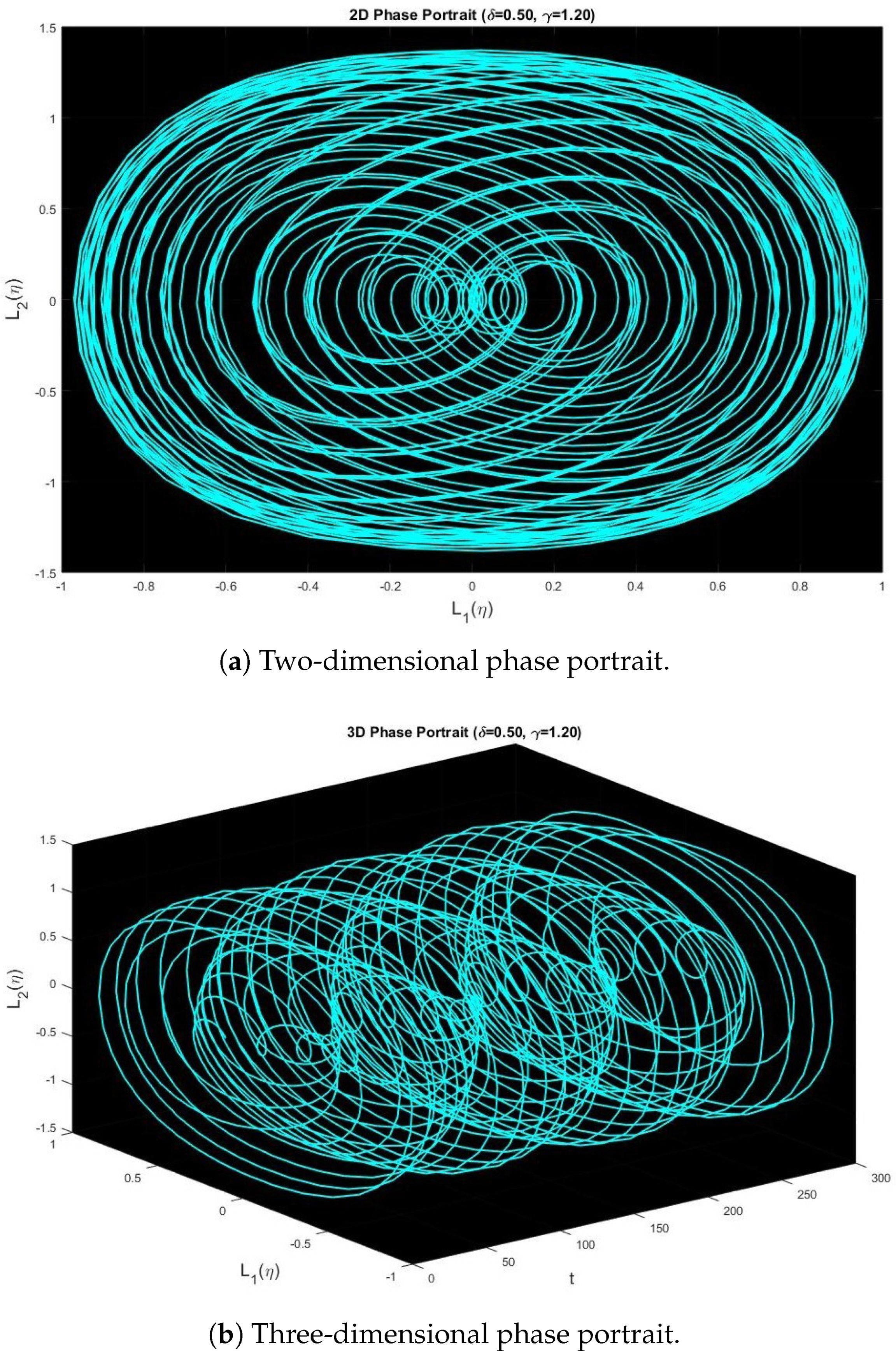
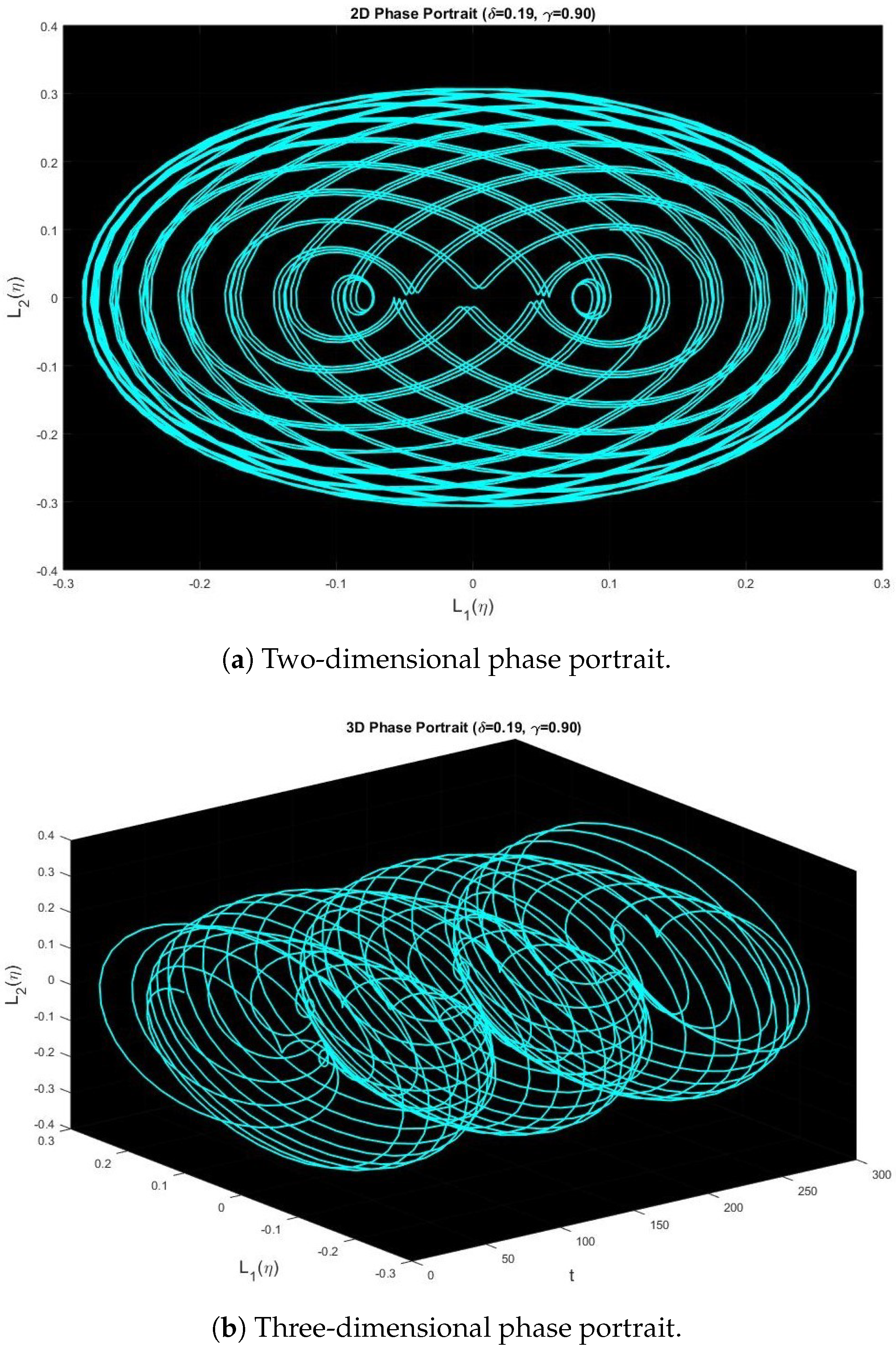
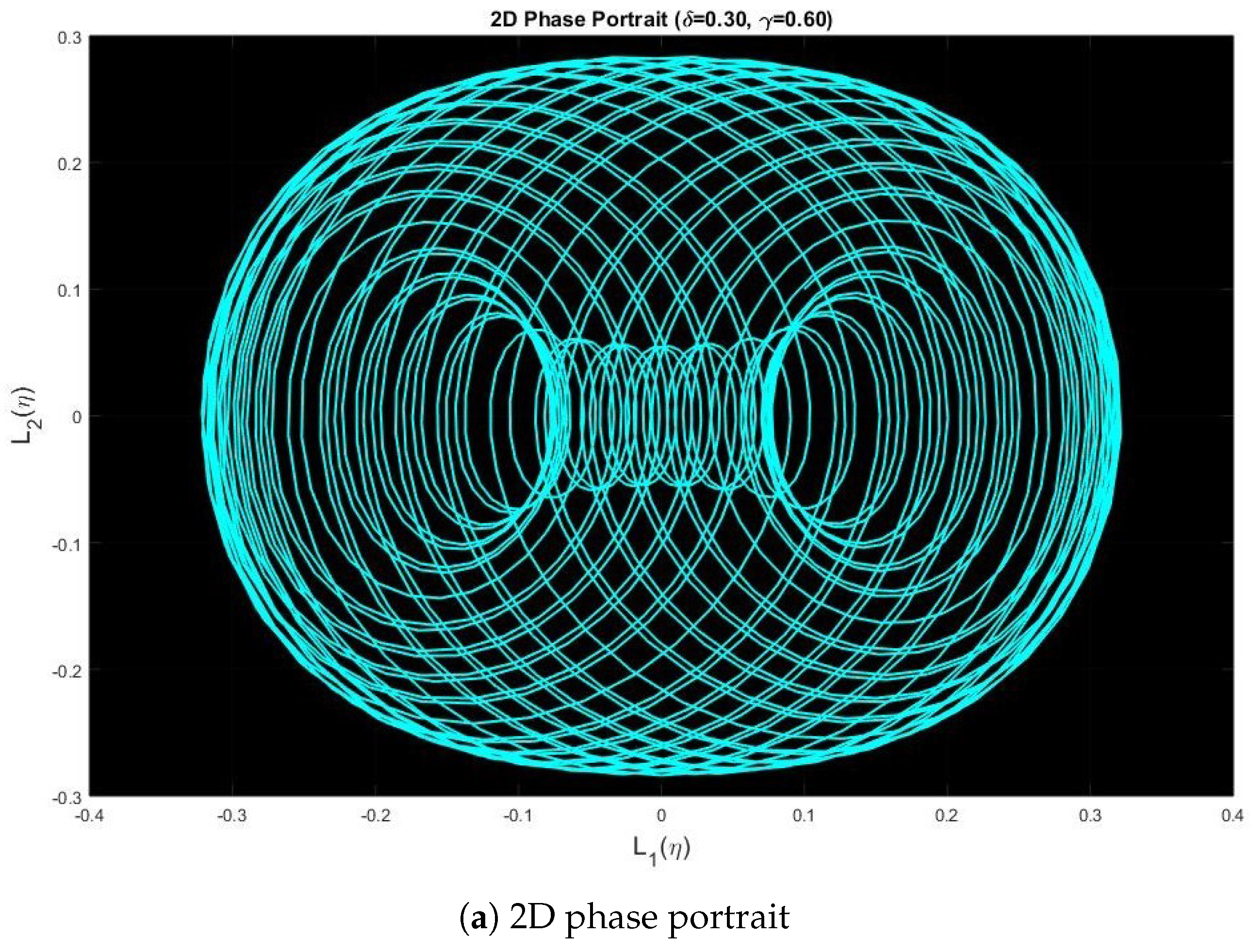

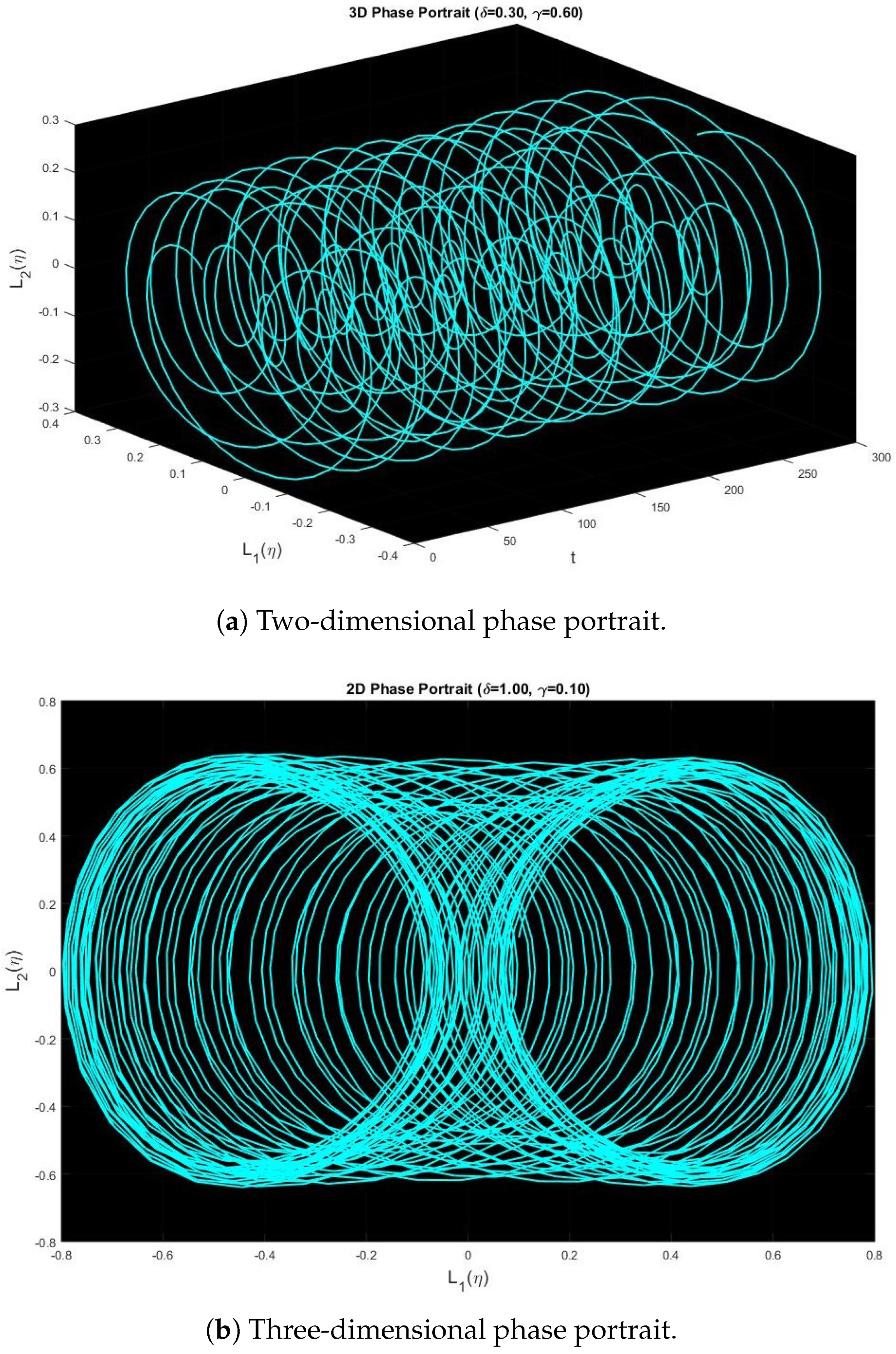
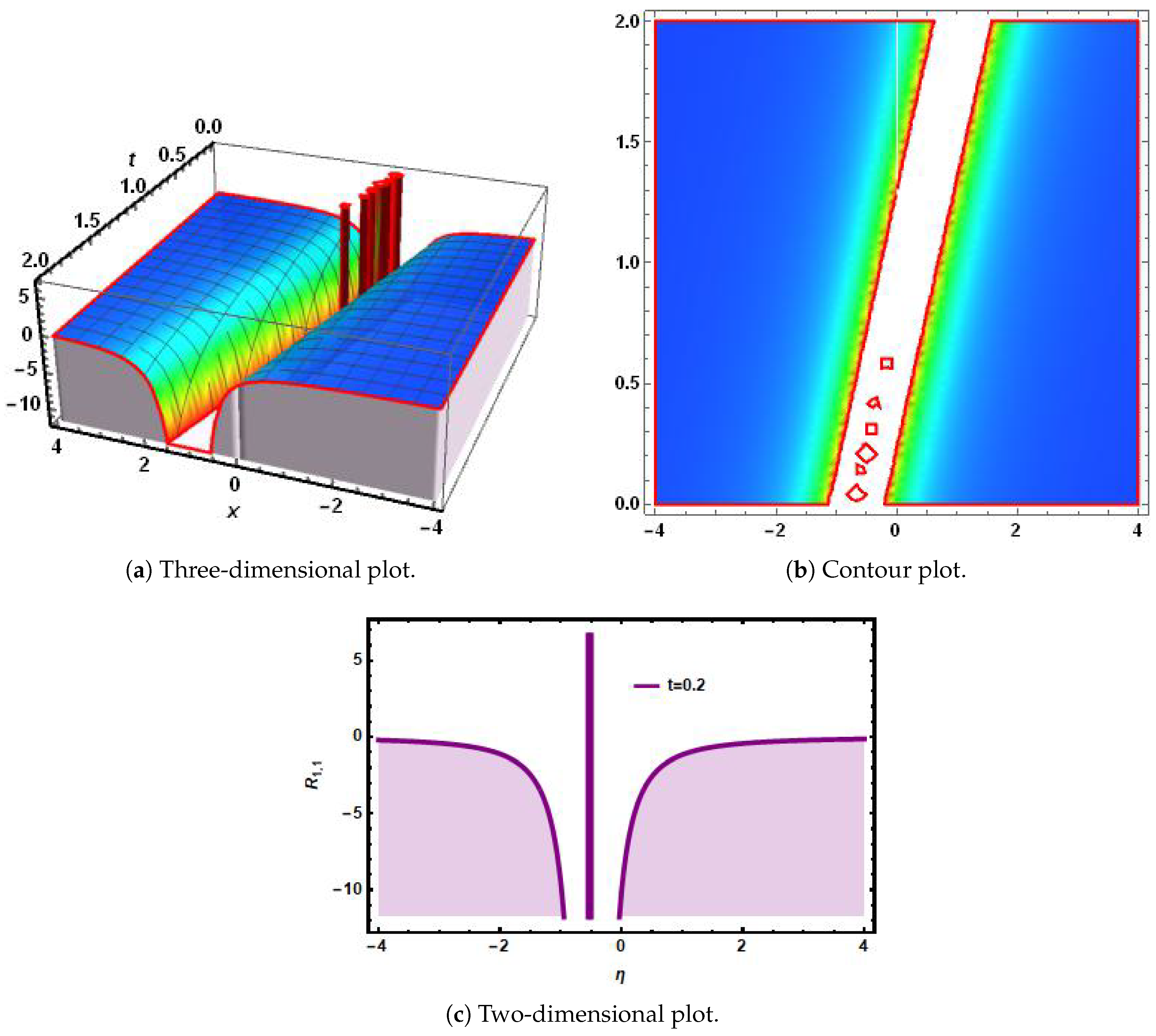
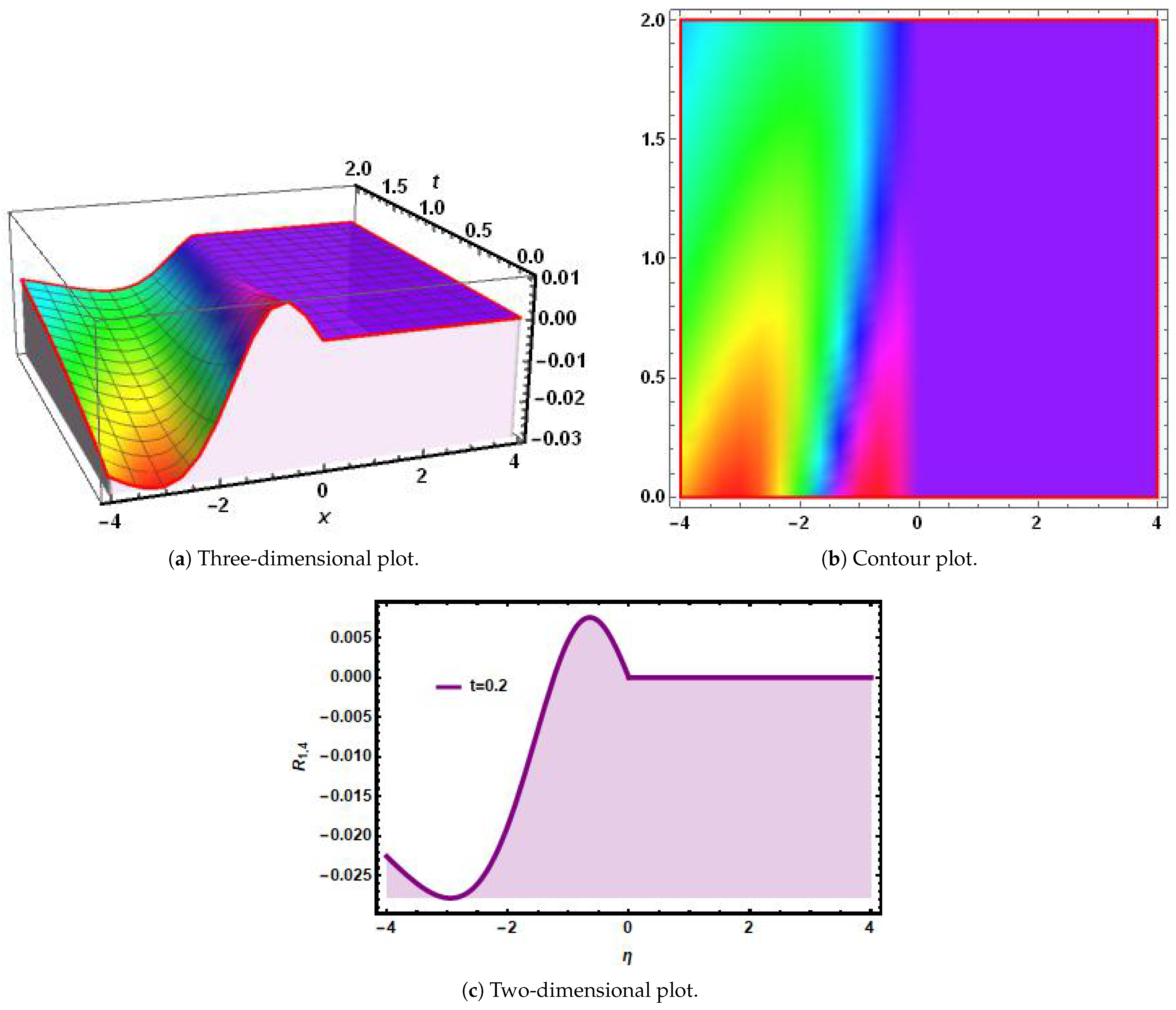
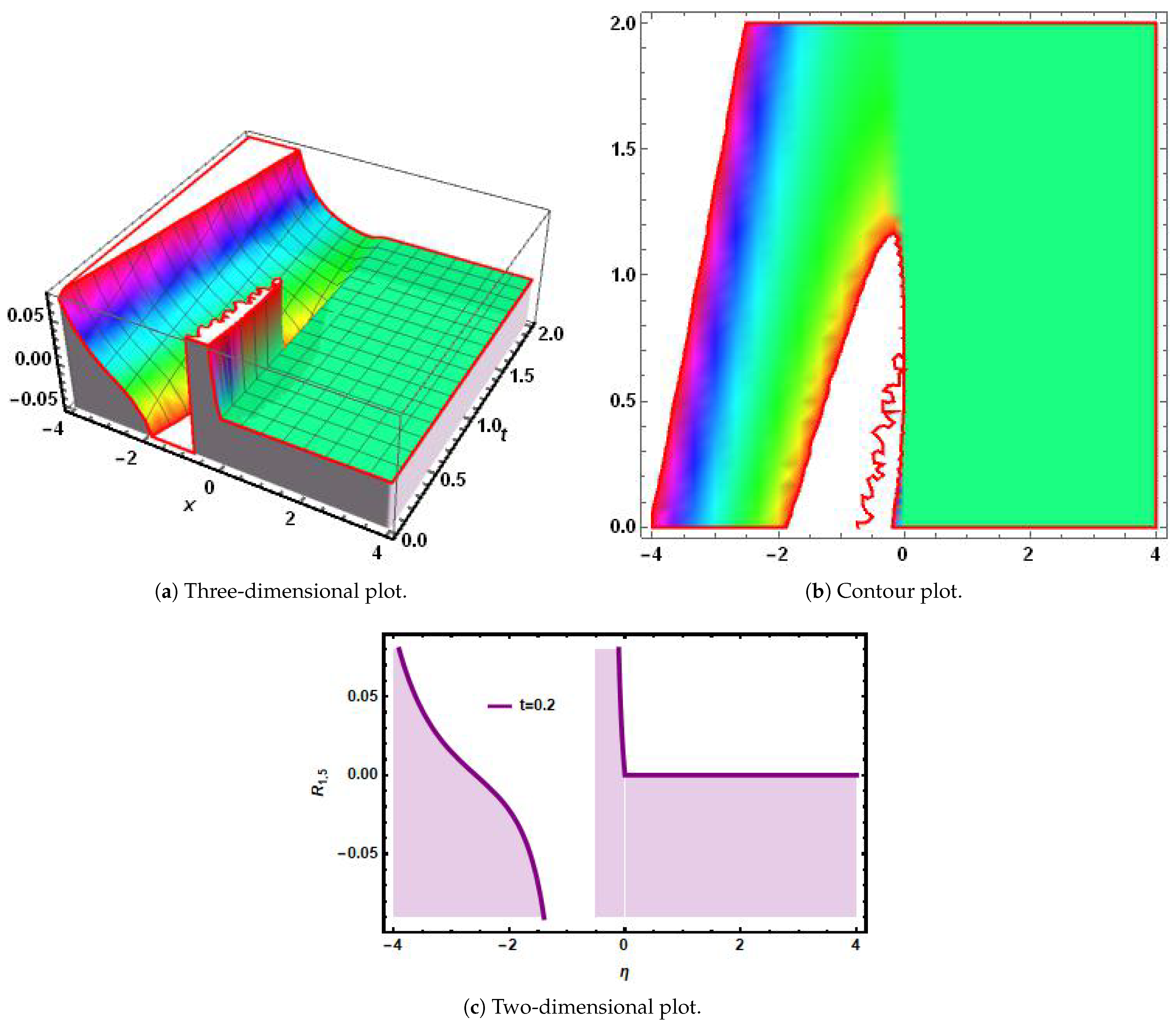
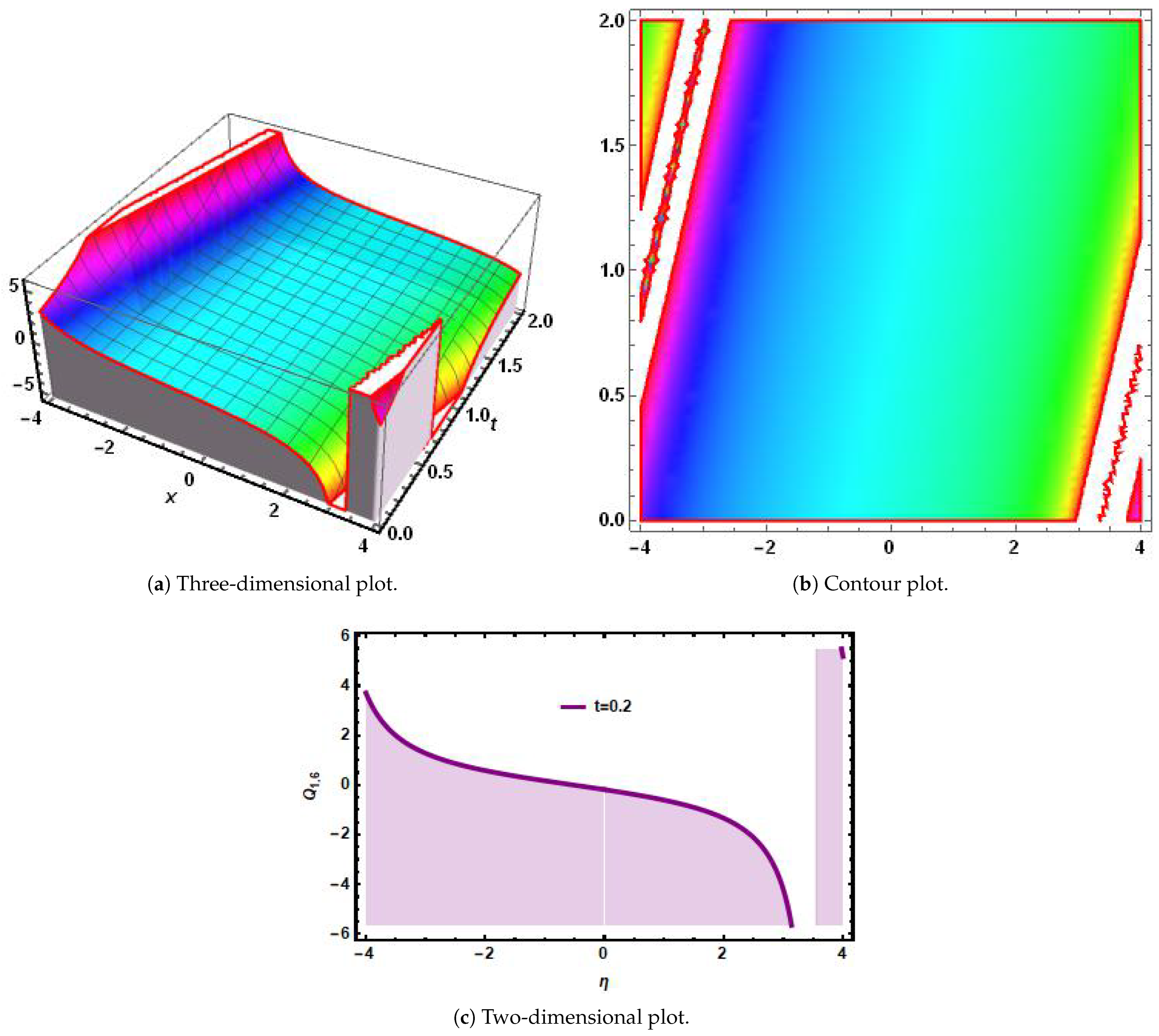
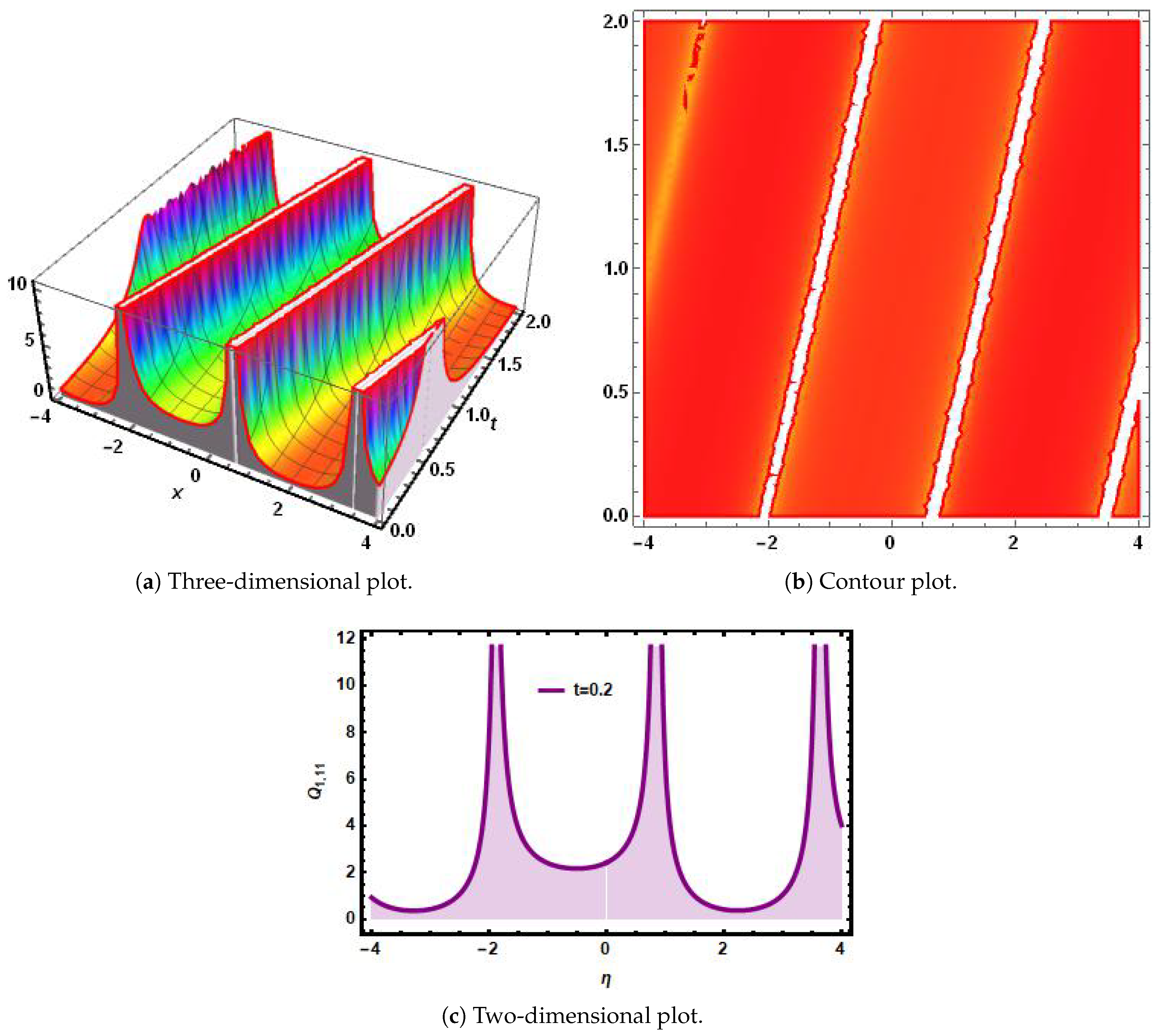
Disclaimer/Publisher’s Note: The statements, opinions and data contained in all publications are solely those of the individual author(s) and contributor(s) and not of MDPI and/or the editor(s). MDPI and/or the editor(s) disclaim responsibility for any injury to people or property resulting from any ideas, methods, instructions or products referred to in the content. |
© 2025 by the authors. Licensee MDPI, Basel, Switzerland. This article is an open access article distributed under the terms and conditions of the Creative Commons Attribution (CC BY) license (https://creativecommons.org/licenses/by/4.0/).
Share and Cite
Afridi, M.I.; Karakasidis, T.E.; Alhushaybari, A. Chaotic Analysis and Wave Photon Dynamics of Fractional Whitham–Broer–Kaup Model with β Derivative. Fractal Fract. 2025, 9, 287. https://doi.org/10.3390/fractalfract9050287
Afridi MI, Karakasidis TE, Alhushaybari A. Chaotic Analysis and Wave Photon Dynamics of Fractional Whitham–Broer–Kaup Model with β Derivative. Fractal and Fractional. 2025; 9(5):287. https://doi.org/10.3390/fractalfract9050287
Chicago/Turabian StyleAfridi, Muhammad Idrees, Theodoros E. Karakasidis, and Abdullah Alhushaybari. 2025. "Chaotic Analysis and Wave Photon Dynamics of Fractional Whitham–Broer–Kaup Model with β Derivative" Fractal and Fractional 9, no. 5: 287. https://doi.org/10.3390/fractalfract9050287
APA StyleAfridi, M. I., Karakasidis, T. E., & Alhushaybari, A. (2025). Chaotic Analysis and Wave Photon Dynamics of Fractional Whitham–Broer–Kaup Model with β Derivative. Fractal and Fractional, 9(5), 287. https://doi.org/10.3390/fractalfract9050287









